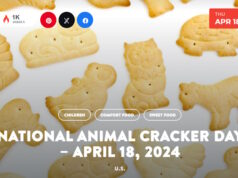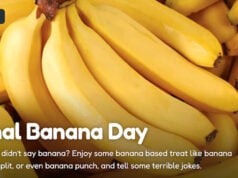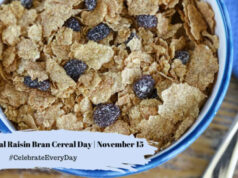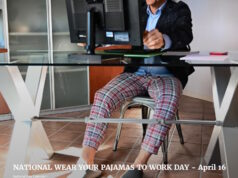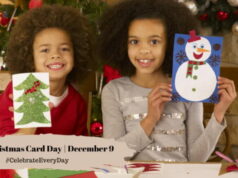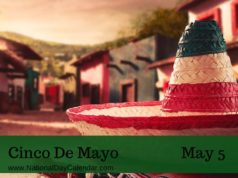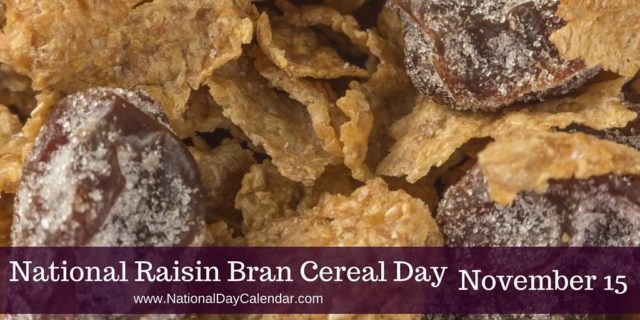
National Raisin Bran Cereal Day is observed and enjoyed each year on November 15.
Since 1926, raisin bran cereal has been manufactured by a number of different companies under a variety of brand names, including Kellogg’s Raisin Bran, General Mills, Total Raisin Bran and Ralcorp’s Post Raisin Bran. U.S. Mills introduced Skinner’s Raisin Bran to the United States in 1926, which was the first brand on the market.
A good source of dietary fiber, raisin bran cereal is the star of the day, not just at breakfast but all day, on National Raisin Bran Cereal Day.
- “Skinner’s Raisin Bran” was the first bran brand on the market, introduced in the United States in 1926 by U.S. Mill.
- During his incarceration, former Iraqi dictator Saddam Hussein preferred Raisin Bran cereal for breakfast given by his American prison guards.
- The first cold breakfast cereal, Granula, was invented in the United States in 1863 by James Caleb Jackson, operator of Our Home on the Hillside which was later replaced by the Jackson Sanatorium in Dansville, New York.
- Twenty-six percent of Americans snack on cereal during the day; 61 percent of that group is women.
- Kellogg’s was the first company to advertise on the Times Square billboard in New York.
- Forget tigers, frogs and birds, Kellogg’s raised the bar the bar on cereal mascots in 1966 when it introduced the center of our solar system as it’s new mascot for their Raisin Bran Cereal. Their sun was a little friendlier than the 4.57 billion year-old white-hot star. It was a smiling animated character named Sunny.
- The term “raisin bran” isn’t actually trademarked, so Kellogg’s, Post, and General Mills all sell their own (nearly identical) versions of the product (General Mills’ is called Total Raisin Bran). The product was actually first introduced in 1926 by a company that doesn’t exist anymore, named Skinner’s. Skinner held the trademark to the name until 1944, when a court stripped it from them because the name was “merely descriptive of the ingredients.”
- Kellogg’s Raisin Bran began using its “two scoops of raisins in every box” slogan in the late 1960’s. According to The Science Creative Quarterly, a 15 ounce box of Kellogg’s Raisin Bran contains between 201 and 241 raisins, which leads us to the conclusion that a scoop contains roughly 100 to 120 raisins.
- In 1952 Frosted Flakes were introduced to the breakfast scene and Tony the Tiger became one of the most famous mascots in the food industry.
- In 1984 Cinnamon Toast Crunch was invented and used a marketing strategy of three cartoon bakers, Wendell, Bob, and Quello, in their ads. In 1991 the cereal brand got rid of Bob and Quello because they weren’t testing well with their audience but kept the lovable Wendell.
- Lester Borchardt was a physicist working for General Mills who spent more than $150,000 to try to get a machine that could make the cereal efficiently and quickly. His bosses told him to stop but he pressed on and eventually made a machine that could churn out the tiny ‘o’s and originally called them Cheerioats, but Quaker Oats claimed trademark infringement and so they changed the name to Cheerios.
- Honey Bunches of Oats was designed by Vernon J. Herzing by using ingredients at the cereal factory, Post’s Battle Creek, he was a manager at. Eventually he came upon the combination that the cereal uses today while at his home with his teenage daughter and originally called it “Battle Creek Cereal.”
- Corn Flakes were actually created by accident: There was a movement among Seventh-day Adventists in the late 1800s to stick to a diet of bland vegetarian foods (long story), and at Michigan’s Battle Creek Sanitarium superintendent John Harvey Kellogg decided to develop some new bland foods for his guests. So he tasked his younger brother Will Keith Kellogg with coming up with some recipes. Will accidentally left a batch of cooked corn and wheat sitting out one day, and when he returned he discovered that it had gone stale. After some experimentation, Corn Flakes were born. And as for the rooster mascot? One of Kellogg’s friends, named Nansi Richards, was a legendary Welsh harpist, and she pointed out that the Welsh word for rooster is ceiliog, whose pronunciation sounds very similar to Kellogg.
- Kellogg’s Apple Jacks were invented in 1965 by a summer research assistant on break from MIT named William Thilly; today he’s a professor at the school. Originally launched as Apple O’s, the name was changed to Apple Jacks in 1975. The cereal was entirely orange until 1998, when green rings were introduced. The cereal’s longtime mascots were a boy and girl named the Apple Jacks Kids, but today the mascots are a clumsy apple named Bad Apple and a Jamaican cinnamon stick named CinnaMon (seriously).
- Kellogg’s Rice Krispies first hit shelves in 1928, making them one of the oldest cereal brands around. They’re made by forming a paste of mostly rice and sugar, then cooking, drying, and toasting it; the famed “snap, crackle, and pop” occur when thin, hollow walls created during the drying process collapse. The characters Snap, Crackle, and Pop have been around since the 1930s, and are the longest-running Kellogg’s cartoon mascots. The cereal is called Rice Bubbles in Australia and New Zealand.
- Corn Pops has gone through more name changes than just about any other cereal: It was introduced by Kellogg’s in 1950 as Corn Pops, but the name was changed to Sugar Corn Pops in 1951, then Sugar Pops, then Sugar Corn Pops in 1978, then back to Corn Pops in 1984 (when the word “sugar” was removed from just about all cereal names), then to Pops in 2006, and then finally back to Corn Pops later that year. They’re relatively flat and smooth in the US, but in Canada they’re spherical, closely resembling Kix.
- Kellogg’s introduced Froot Loops (and its famed mascot, Toucan Sam) in 1963; the cereal doesn’t contain any actual fruit, and contrary to popular belief, all colors are the same exact flavor. Froot Loops were originally only red, orange, and yellow, but in the 1990s green, purple, and blue were added.
- The brand that began in 1955 as a humble rice and wheat cereal has become a dieting empire. Special K’s hot streak started when it introduced the Special K Challenge, a weight loss program Kellogg initially developed as a way for Kellogg to save money over broadcast advertising.
Sources:



